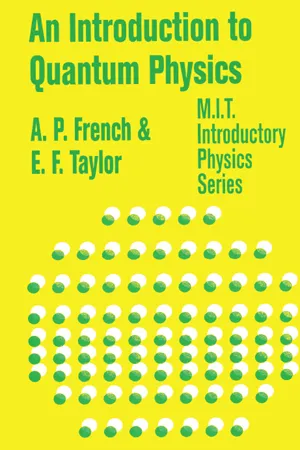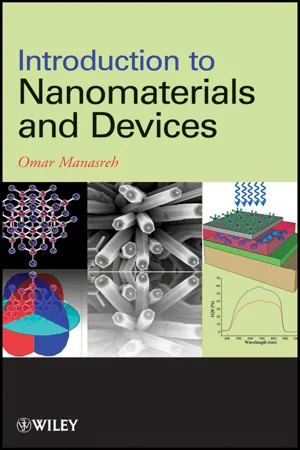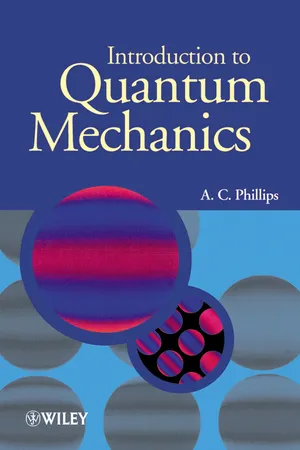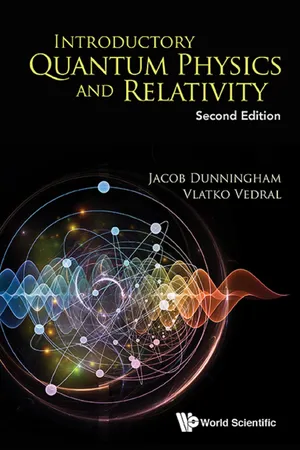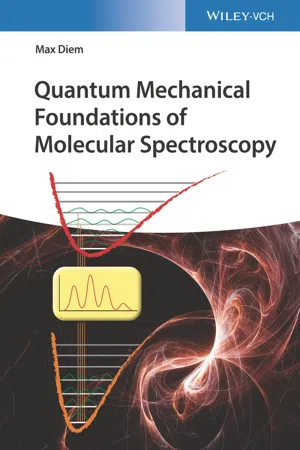Physics
Infinite Square Well
The infinite square well is a theoretical model used in quantum mechanics to describe a particle confined within a potential well of infinite depth. The potential energy within the well is zero, and the particle's wave function is zero outside the well. This model is often used to introduce the concept of quantization and boundary conditions in quantum mechanics.
Written by Perlego with AI-assistance
Related key terms
Related key terms
1 of 4
Related key terms
1 of 3
7 Key excerpts on "Infinite Square Well"
- eBook - ePub
- A.P. French(Author)
- 2018(Publication Date)
- Routledge(Publisher)
lower than for the infinite well. This qualitative conclusion will have quantitative verification in a later section.Fig. 3-12 (a) Finite square well as in Figure 3-10 (a), with second allowed energy indicated. (b) Wave function for the second energy state.Fig. 3-13 In finite square well and finite square well compared. The Infinite Square Well and the wave functions for the two lowest states are sketched across the top. Below them are the corresponding graphs for the finite square well. The de Broglie wavelength within the well is longer for any given bound state of the finite square well than for the corresponding state of the Infinite Square Well.The exponential decrease of the wave function outside the square well for the second energy state is less rapid than is the corresponding decrease for the lowest energy state as indicated in Figure 3-13 . This is because the quantity (V − E) is smaller in the exponential decay constant α = [2m(V − E)]1/2 /ħ.As an exercise, draw the probability density function for the second energy level in the finite square well. What is the physical significance of the total area under this probability curve? Draw the wave function and the probability density function for the third energy level in the finite square well, paying attention to the exponential decay constant outside the well relative to those for the first two levels. For the “lopsided” square well potential of Figure 3-14 , sketch the wave functions for the first three energy levels and the probability density functions for all three states.Fig. 3-14 Lopsided square well, for which you are asked to sketch the wave functions and probability densities for the first three energy states. - eBook - ePub
Quantum Wells, Wires and Dots
Theoretical and Computational Physics of Semiconductor Nanostructures
- Paul Harrison, Alex Valavanis(Authors)
- 2016(Publication Date)
- Wiley(Publisher)
Chapter 2 Solutions to Schrödinger’s equation 2.1 The infinite well The infinitely deep one-dimensional potential well is the simplest confinement potential to treat in quantum mechanics. Virtually every introductory-level text on quantum mechanics considers this system, but nonetheless it is worth visiting again as some of the standard assumptions, often glossed over, do have important consequences for one-dimensional confinement potentials in general. The time-independent Schrödinger equation summarises the wave mechanics analogy to Hamilton’s formulation of classical mechanics [1] for time-independent potentials. In essence this states that the kinetic and potential energy components sum to the total energy; in wave mechanics, these quantities are the eigenvalues of linear operators, i.e. 2.1 where the eigenfunction ψ describes the state of the system. Again in analogy with classical mechanics, the kinetic energy operator for a particle of constant mass is given by: 2.2 where is the usual quantum mechanical linear momentum operator: 2.3 By using this form for the kinetic energy operator, the Schrödinger equation then becomes: 2.4 where the function V (x, y, z) represents the potential energy of the system as a function of the spatial coordinates. Restricting this to the one-dimensional potential of interest here, the Schrödinger equation for a particle of mass m in a potential well aligned along the z -axis (as in Fig. 2.1) would be: 2.5 Figure 2.1 The one-dimensional infinite well confining potential Outside of the well, V (z) = ∞, and hence the only possible solution is ψ (z) = 0, which in turn implies that all values of the energy E are allowed. Within the potential well, the Schrödinger equation simplifies to: 2.6 which implies that the solution for ψ is a linear combination of the functions f (z) which when differentiated twice give − f (z) - eBook - ePub
- Omar Manasreh(Author)
- 2011(Publication Date)
- Wiley-Interscience(Publisher)
Figure 2.8 A schematic diagram showing the tunneling of a particle through a potential barrier is plotted for the three regions. The wave function inside the barrier is a decaying (evanescent) function.2.8 Potential Well with an Infinite DepthLet us consider a potential well with an infinite depth as shown in Fig. 2.9 where V (x ) is zero for 0 < x < L and infinite everywhere else. Inside the quantum well, the Schrödinger equation is2.95By setting the propagation vector as , where E > 0, we obtain the following Schrödinger equation2.96The general solution of this equation is2.97The boundary conditions in this case is φ(0) = φ(L ) = 0. Thus, B in Equation 2.97 must be zero, reducing the wave function to φ(x ) = A sin(kx ). To have a nontrivial solution at x = L , A ≠ 0, which implies that sin(kL ) = 0. Hence,2.98By substituting the expression of k into Equation 2.98 , one can obtain the eigenvalues as2.99By normalizing the wave function and substituting for k = 2π/L , we can finally write the wave function as2.100The example of the potential well when it is defined such that V 0 = 0 for − L /2 ≤ x ≤ + L /2 can be solved by performing the following transformation x → x − L /2. The wave function becomes2.101By expanding the sine function, we obtain the following:2.102For n = 1, 3, 5, … , the wave function is proportional to , which is an even function. For n = 2, 4, 6, … , the wave function is proportional to , which is an odd function. Thus, for −L /2 < x < + L /2, the wave function is given as2.103The energy levels and the probability functions of a particle in an infinite potential well are shown in Fig. 2.10 . The energy levels are proportional to n 2 as indicated in Equation 2.99 - eBook - ePub
- A. C. Phillips(Author)
- 2013(Publication Date)
- Wiley(Publisher)
5
Square wells and barriers
Insight into how quantum particles can be bound or scattered by potential energy fields can be obtained by considering models based on square wells and square barriers. In these models, the Schrödinger equation may be solved easily using elementary mathematics, the possible energies of a particle may be found and the properties of the wave functions are self-evident.We begin by considering the quantum states of a particle in a one-dimensional square-well potential. We shall show that there are unbound states with a continuous range of energies and that there are, when the well is deep enough, bound states with discrete energies.We shall then consider a particle incident on a square potential barrier. We shall see that this is an uncertain encounter with two possible outcomes: reflection and transmission. Most importantly, we shall show that transmission is possible even when the particle has insufficient energy to surmount the barrier. In other words, we shall illustrate how quantum particles can tunnel through potential barriers.5.1 BOUND AND UNBOUND STATES
In order to explore the properties of bound and unbound quantum states in a simple context, we shall consider a particle of mass m in the one-dimensional potential energy field given by(5.1)As illustrated in Fig. 5.1 , the potential energy changes abruptly at x = 0 and x = a. There is an attractive well of depthV0 ,which may or may not trap the particle, and an infinite wall at x = 0 which repels the particle.Fig. 5.1 The potential energy field given by Eq. (5.1) in which there are unbound states with a continuous range of energies and, if the well is deep enough, bound states with discrete energies.The behaviour of a classical particle in this potential should be familiar. The energy of the particle, E, - eBook - ePub
- Jacob Dunningham, Vlatko Vedral(Authors)
- 2018(Publication Date)
- WSPC(Publisher)
1This means that we need to ensure that the plane wave solutions inside the box continuously match the solutions outside it, i.e. ψ(0) = ψ(L) = 0. These are called boundary conditions and restrict the solutions that are allowed. The plane-wave solutions inside the box are eikn x and e−ikn xor, equivalently, cos(knx) and sin(kn x). The most general solution inside the box is therefore2where A and B are constants. The conditions at the boundaries givewhere we have made use of the result B = 0 in the second line. The second condition restricts what values of kFigure 4.1:Wave functions of the first three energy levels for a particle in an Infinite Square Well.nare allowed. In particular, we need knL = nπ, where n is an integer. In other words, the allowed wave functions inside the box arewith corresponding quantised energiesThis is exactly what we found before with our intuitive argument.The constant A can be found by normalisation:which gives . The wave functions for different values of n are shown in Fig. 4.1 .There are many physical examples for which the Infinite Square Well is a surprisingly accurate and useful model. Let us, for example, try to calculate the lowest energy level for an electron in a hydrogen atom. Imagine that the electron is confined in a box of size 10−10 m, which is a typical atomic size. The energy in the lowest level is thenThis is roughly 10eV, and the real energy is 13.6eV, a remarkably close estimate.What happens to the energy of the particle if the size of the box gets smaller? Then the energy goes up with an inverse square relation of that size. Therefore, the more you try to confine quantum particles, the more energetic they get as they resist confinement. The floor you stand on is made up of atoms, and each of these has a nucleus and a bunch of electrons whizzing around. But most of the space in the atom is empty, since the nucleus and electrons are very small compared to the size of the atom. How is it that you do not fall through the floor? The usual answer is that the force of electromagnetic repulsion keeps you on the floor, but, it is in fact, the power of the uncertainty principle. - Max Diem(Author)
- 2021(Publication Date)
- Wiley-VCH(Publisher)
Here, an electron would be confined in a box with dimensions L x in the x ‐direction and L y in the y ‐direction, with zero potential energy inside the box and infinitely high potential energy outside the box: (2.42) The Hamiltonian for this system is (2.43) and the total wavefunction ψ x, y can be written as (2.44) where A as before is an amplitude (normalization) constant. The total energy of the system is (2.45) Figure 2.4 Wavefunctions of the two‐dimensional particle in a box for (a) n x = 1 and n y = 2 and (b) n x = 2 and n y = 1. For a square box with L x = L y = L, the energy expression simplifies to (2.46) The wavefunctions can now be represented as shown in Figure 2.4 for the cases n x = 2 and n y = 1 and n x = 1 and n y = 2. These wavefunctions represent the standing wave on a square drum. Notice that the energy eigenvalues for these two cases are the same: (2.47) When two or more energy eigenvalues for different combination of quantum numbers are the same, these energy states are said to be degenerate. Here, for n x = 2 and n y = 1 and n x = 1 and n y = 2, the same energy eigenvalues are obtained; consequently, E 21 and E 12 are degenerate. This is a common occurrence in quantum mechanics, as will be seen later in the discussion of the hydrogen atom (Chapter 7), where all the three 2p orbitals, the five 3d orbitals, and the seven 4f orbitals are found to be degenerate. 2.4.2 The Unbound Particle Next, the case of a system without the restriction of the boundary conditions (an unbound particle) will be discussed. This discussion starts with the same Hamiltonian used before: (2.23) When this differential equation is solved without the previously used boundary conditions (2.29) the new solutions represent a particle–wave that travels along the positive or negative x ‐direction. The most general solution of the differential Eq. (2.23) is (2.48) where b is a constant. The second derivative of Eq- eBook - ePub
- Gerald D. Mahan(Author)
- 2008(Publication Date)
- Princeton University Press(Publisher)
2 and is the kinetic energy of the spread in wave vectors.Homework
1. Derive the numerical value in eV for the bound-state energy of an electron in the one-dimensional square-well potential:where b = 1.0 and V 0 = 1.0 eV. What is the critical value of coupling strengthgcfor this potential?2. Make a graph similar to figure 2.8 of the solutions of eqn. (2.37) over the range of 0 < g < 10. Show that new bound states start at .3. A particle in a one-dimensional square well of infinite sides is confined to the interval 0 < x < L . The eigenfunctions are given in eqn. (2.19). Prove the relationby evaluating the summation, and determine the constant C .4. For the potential shown in figure 2.1 , prove eq. (2.51) by doing the integral. B and k are the bound and continuum eigenfunctions.5. Consider in one dimension the solutions to Schrödinger’s equation for the half-space problem (V 0 > 0):Find an expression for the phase shift δ (k ) for the two cases (a) 0 < E < V 0 and (b) V 0 < E .6. Consider a particle of energy E > V 0 > 0 approaching a potential step from the left. The Hamiltonians in the two regions arewheremL≠ m R .Find the amplitude of the transmitted (T ) and reflected wave (R ), by matching at x = 0 the amplitude of the wave function and the derivativeShow that this choice of matching conserves the current of the particles.7. A particle of mass m moves in a one-dimensional square-well potential with walls of infinite height: the particle is constrained in the region −L /2 < x < L /2.a. What are the eigenvalues and eigenfunctions of the lowest two states in energy? b. What is the expectation value of the energy for a state that is an equal mixture of these two states? c. For the state in (b), what is the probability, as a function of time, that the particle is in the right-hand side of the well?
Index pages curate the most relevant extracts from our library of academic textbooks. They’ve been created using an in-house natural language model (NLM), each adding context and meaning to key research topics.
Explore more topic indexes
Explore more topic indexes
1 of 6
Explore more topic indexes
1 of 4
